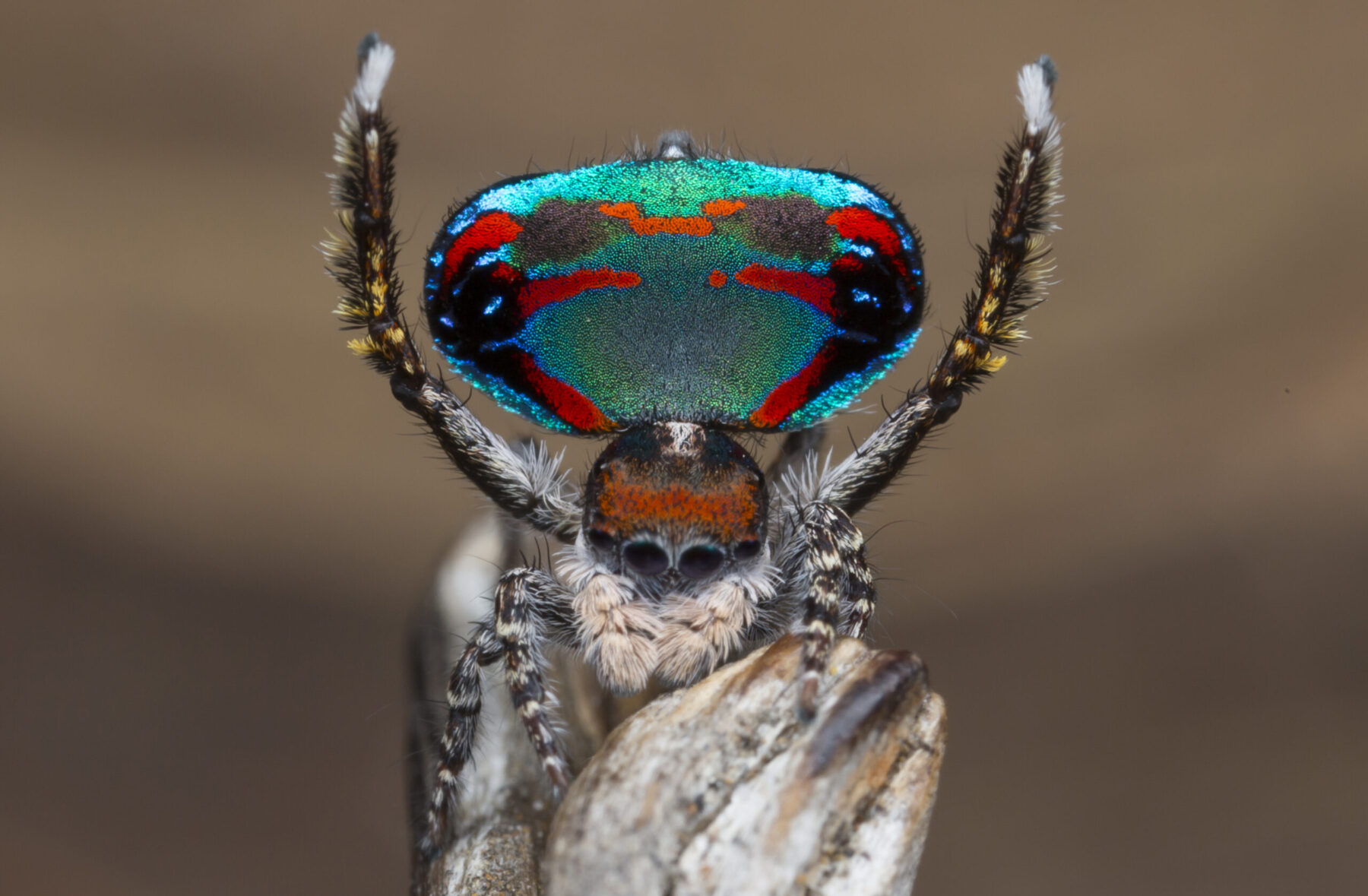Australia’s peacock spiders are tiny, vibrant performers, captivating scientists and nature lovers alike with their dazzling colors and intricate mating dances. Unlike most animals with just a handful of species, these pinhead-sized arachnids boast over 100 unique varieties, a diversity that has puzzled researchers for years. Recent studies point to a mysterious element in their genetic code—“dark DNA”—as a key to their rapid evolution. In this article, we’ll explore the science behind these dancing spiders, the role of dark DNA, and what their diversity reveals about the natural world. Drawing on the latest research and my own fascination with Australia’s quirky wildlife, I’ll share why these spiders are more than just a spectacle—they’re a window into evolution itself.
What Are Peacock Spiders?
Peacock spiders, scientifically known as Maratus, are tiny arachnids found across Australia, renowned for their colorful abdomens and elaborate courtship rituals. Males perform rhythmic dances, complete with drumming sounds and vibrant displays, to woo females. With over 100 species, their diversity in appearance, behavior, and “songs” is unmatched among most animals, making them a focal point for evolutionary research.
The Charm of Their Dance
Picture a spider the size of a grain of rice, strutting like a peacock with a kaleidoscope of colors flashing on its abdomen. These performances, often likened to a Broadway show, involve precise leg movements and foot-drumming “songs.” I first saw a video of a Maratus volans dance online, and it was like watching a miniature disco—utterly mesmerizing!
Why So Many Species?
While most animal genera have 5–10 species, peacock spiders have exploded into over 100. Researchers believe this speciation is driven by unique environmental adaptations and sexual selection, where females choose mates based on their dance and colors. This diversity caught the eye of scientists like Jonah Walker at the Sanger Institute, who are digging into their DNA for answers.
The Role of Dark DNA in Spider Evolution
Dark DNA, the non-coding regions of genetic material, is emerging as a key player in the peacock spider’s extraordinary diversity. Unlike genes that dictate traits like eye color, dark DNA’s function is largely unknown, yet it makes up a significant portion of their genome. Scientists suspect it allows these spiders to adapt rapidly, creating new species in response to environmental changes.
What Is Dark DNA?
Dark DNA refers to the non-coding sections of DNA that don’t directly produce proteins but may regulate gene expression or influence evolution. In peacock spiders, it’s three times more abundant than in humans. Researchers like Dr. Joana Meier suggest it could act like a genetic “wildcard,” enabling rapid diversification.
How Dark DNA Drives Speciation
By analyzing the DNA of all known peacock spider species, scientists found that dark DNA might control how genes are expressed, leading to unique traits like distinct dance moves or color patterns. This flexibility could explain why peacock spiders form new species faster than other animals. It’s like they’ve got an evolutionary fast-pass!
Comparing Dark DNA Across Species
| Species | Dark DNA Proportion | Species Count |
|---|---|---|
| Peacock Spiders | ~75% of genome | 100+ |
| Humans | ~25% of genome | 1 |
| Butterflies/Moths | ~60% of genome | 1000+ |
Insight: Higher dark DNA correlates with greater species diversity, as seen in spiders and butterflies.
The Science Behind the Research
Led by Jonah Walker and Dr. Joana Meier at the Sanger Institute, researchers are decoding the peacock spider’s genetic puzzle as part of the Earth BioGenome Project. They’ve collected samples from every known species, cataloging behaviors, movements, and songs, then cross-referencing these with DNA data. Their early findings suggest dark DNA is a major driver of the spiders’ diversity.
Collecting and Cataloging Species
The team scoured Australia to gather specimens, a task Jonah Walker described as daunting due to his initial fear of spiders. “A few seconds of watching them dance washed away any fears,” he told BBC News. Each species’ unique traits—colors, dance moves, and sounds—were meticulously documented for analysis.
DNA Sequencing and Analysis
Using cutting-edge sequencing, the team compared DNA across species to identify which genes or dark DNA regions influence specific traits. This process, still in early stages, aims to pinpoint how genetic variations lead to new species. The work is part of a larger effort to decode the DNA of all 1.8 million living species.
The Earth BioGenome Project
This ambitious project seeks to map the genomes of every plant, animal, and fungus on Earth within a decade. With 3,000 species sequenced so far, peacock spiders are a key focus due to their extreme diversity. The project’s insights could reshape our understanding of evolution across all life forms.
Why Peacock Spiders Are Unique
Peacock spiders stand out not just for their diversity but for their ecological and behavioral quirks. Found across Australia’s varied landscapes, from woodlands to deserts, these tiny creatures adapt to niche environments. Their mating rituals, driven by sexual selection, amplify their diversity, as females favor males with the most striking displays.
Their Vibrant Mating Rituals
Males use their colorful abdomens like peacock feathers, flashing patterns during rhythmic dances. They also drum their feet to create unique “songs.” Each species has a distinct routine, like Maratus constellatus, whose abdomen resembles Van Gogh’s Starry Night. It’s nature’s version of a talent show
Ecological Adaptability
Peacock spiders thrive in diverse habitats, from coastal dunes to inland scrublands. Their ability to speciate rapidly may stem from adapting to these microenvironments. Dark DNA could regulate how they adjust to changing climates or food sources, fueling new species formation.
Comparison: Peacock Spiders vs. Other Arachnids
| Feature | Peacock Spiders | Funnel-Web Spiders |
|---|---|---|
| Size | Pinhead-sized | Up to 2 inches |
| Behavior | Courtship dances | Aggressive hunters |
| Diversity | 100+ species | ~40 species |
| Habitat | Varied microenvironments | Sydney region |
Insight: Peacock spiders’ diversity far exceeds that of other Australian arachnids, like the funnel-web.
Challenges in Studying Peacock Spiders
Studying these tiny creatures is no small feat. Their size, elusive nature, and complex behaviors pose unique challenges for researchers. Yet, the rewards—uncovering the secrets of evolution—are worth the effort, as Jonah Walker’s journey from arachnophobe to spider enthusiast shows.
Finding and Observing Tiny Spiders
At the size of a grain of rice, peacock spiders are hard to spot in the wild. Researchers like Joseph Schubert spend hours on their knees with macro lenses, as he shared with ABC News. Their small size and fast movements make observation a test of patience and precision.
Decoding Complex Behaviors
Cataloging each species’ unique dance and song requires meticulous attention. The team records movements and sounds, then matches them to DNA data. This painstaking process is like assembling a puzzle with thousands of tiny, colorful pieces.
Pros and Cons of Studying Dark DNA
Pros:
- Uncovers new insights into evolution.
- Contributes to global genomic projects.
- Helps explain biodiversity in other species.
Cons:
- Dark DNA’s function is still largely unknown.
- Sequencing and analysis are time-intensive.
- Requires advanced technology and funding.
Tools and Resources for Studying Peacock Spiders
For researchers and enthusiasts alike, studying peacock spiders requires specialized tools and access to reliable resources. From field equipment to genetic databases, here’s what you need to dive into their world.
Essential Tools for Arachnology
- Macro Camera: Captures tiny details of spider anatomy and behavior.
- DNA Sequencing Kits: Enables genetic analysis in the lab.
- Field Guides: Books like A Field Guide to Spiders of Australia are invaluable.
Where to Get Tools: Check Amazon or B&H Photo for macro lenses ($200–$500) or QIAGEN for sequencing kits.
Best Resources for Learning More
- Australian Museum: Offers spider collections and research papers.
- Sanger Institute: Shares updates on genomic studies.
- Project Maratus: A volunteer group dedicated to peacock spider research.
Navigational Tip: Visit Australian Museum for arachnology resources or Sanger Institute for genomic data.
People Also Ask (PAA) Section
What Is Dark DNA in Peacock Spiders?
Dark DNA refers to non-coding DNA regions that don’t produce proteins but may regulate gene expression. In peacock spiders, it’s three times more abundant than in humans and may drive their rapid speciation. Researchers are studying it to understand its role in evolution.
Why Do Peacock Spiders Have So Many Species?
Their diversity stems from sexual selection and environmental adaptability. Females choose mates based on unique dances and colors, leading to rapid speciation. Dark DNA may enhance their ability to form new species in diverse habitats.
How Are Scientists Studying Peacock Spider DNA?
Researchers collect specimens, catalog behaviors, and sequence DNA to compare traits across species. They use advanced sequencing to analyze dark DNA’s role in evolution. The Earth BioGenome Project supports this work to map all species’ genomes.
Where Can I See Peacock Spiders in Australia?
Peacock spiders are found across southern Australia, especially in Western Australia’s southwest. Join groups like Project Maratus or visit nature reserves like Stirling Range National Park. A macro lens and patience are key for spotting them.
Broader Implications for Biodiversity
The peacock spider’s dark DNA could unlock secrets about biodiversity beyond arachnids. Similar patterns are seen in butterflies and moths, which also have high dark DNA and numerous species. Understanding these mechanisms could inform conservation efforts and reveal how life adapts to a changing planet.
Lessons for Conservation
By studying how dark DNA drives speciation, scientists can better predict how species respond to environmental shifts. This knowledge could guide efforts to protect Australia’s unique biodiversity, from spiders to marsupials. It’s a reminder of how small creatures can inspire big discoveries.
Connecting to Other Species
Dr. Joana Meier’s work on butterflies shows parallels with peacock spiders, suggesting dark DNA may be a universal driver of diversity. The Earth BioGenome Project aims to connect these dots, mapping DNA across all life forms to uncover evolutionary patterns.
My Own Encounter with Australia’s Wildlife
Years ago, while hiking in Western Australia, I stumbled across a tiny, colorful creature that I later learned was a peacock spider. Its vibrant dance was unlike anything I’d seen—a reminder of nature’s creativity. That moment sparked my curiosity about these arachnids and their role in Australia’s ecosystems. It’s humbling to think that such a small creature could hold clues to life’s biggest questions.
Why This Matters to You
Whether you’re a science enthusiast or just love quirky wildlife, peacock spiders offer a glimpse into nature’s complexity. Their story shows how even the smallest creatures can teach us about resilience and adaptation. Plus, who can resist a spider that dances like it’s auditioning for a talent show?
FAQ Section
What Makes Peacock Spiders So Diverse?
Their diversity comes from sexual selection, where females choose mates based on unique dances and colors, and environmental adaptability. Dark DNA may enhance their ability to form new species rapidly, leading to over 100 varieties.
Can I Study Peacock Spiders Myself?
Yes! With a macro camera and field guide, you can observe them in southern Australia. Join groups like Project Maratus or access resources from the Australian Museum to learn more. Patience and a keen eye are essential.
How Does Dark DNA Differ from Regular DNA?
Dark DNA is non-coding, meaning it doesn’t produce proteins but may regulate genes or influence evolution. It’s more abundant in peacock spiders than humans, potentially driving their rapid speciation.
Are Peacock Spiders Dangerous?
No, peacock spiders are harmless to humans. Their venom targets small invertebrates like flies. Their tiny size and non-aggressive nature make them safe to observe.
Where Can I Learn More About Spider Research?
Check the Australian Museum’s arachnology section or Sanger Institute’s genomic studies. Online platforms like Zootaxa publish peacock spider research. Volunteer with Project Maratus for hands-on opportunities.
Final Thoughts: A Dance of Discovery
Australia’s peacock spiders are more than just nature’s tiny dancers—they’re a testament to the power of evolution. Their mysterious dark DNA holds clues to why life on Earth is so diverse, from vibrant spiders to fluttering butterflies. As researchers like Jonah Walker and Dr. Joana Meier unravel these secrets, we’re reminded that even the smallest creatures can spark big revelations. So, next time you’re in Australia, keep an eye out for these pinhead-sized performers—you might just witness a dance that changes how you see the world.
External Links:


